Читать книгу Plant Nucleotide Metabolism - Hiroshi Ashihara - Страница 64
4.2.11 Synthesis of GMP
ОглавлениеSynthesis of GMP is initiated by the oxidation of IMP followed by the insertion of an amino group that is provided by glutamine. Xanthosine-5′-monophosphate (XMP) formation is catalysed by inosine-5′-monophosphate dehydrogenase (IMPDH, EC 1.1.1.205) using NAD+ as the hydrogen acceptor (step 13, Figure 4.1, Reaction 13).
The native IMPDH has been investigated in seeds of pea (Pisum sativum) (Turner and King 1961), Catharanthus roseus cells and young leaves of tea (Camellia sinensis) (Nishimura and Ashihara 1993) and the soluble proteins of the plant cell fractionation of nitrogen-fixing nodules of cowpea (Vigna unguiculata). The most detailed studies have been with the cowpea enzyme which has an alkaline pH optimum (pH 8.8) and a high affinity for IMP and nicotinamide adenine dinucleotide (NAD). Intermediates of ureide metabolism do not affect the enzyme, while AMP, GMP, and NADH are inhibitors (Atkins et al. 1985). Similar to the cowpea nodule enzymes, the Km values of C. roseus and tea enzymes for IMP are low (∼20 μM) and inhibited by purine nucleotides, especially by GMP (Nishimura and Ashihara 1993). IMPDH is one of the key enzymes of caffeine biosynthesis (Keya et al. 2003). The full length cDNA (TIDH) encoding IMPDH was cloned from tea leaves and the expression of TIDH is highest in leaves where caffeine biosynthesis occurs than in other plant parts (Li et al. 2008). In addition to GMP and caffeine biosynthesis, the enzyme appears to contribute to the biosynthesis of ureides.
The final step in the formation of GMP is catalysed by GMP synthase (GMPS, EC 6.3.5.2) (step 14, Figure 4.1, Reaction 14). Properties of this enzyme have not yet been reported.
